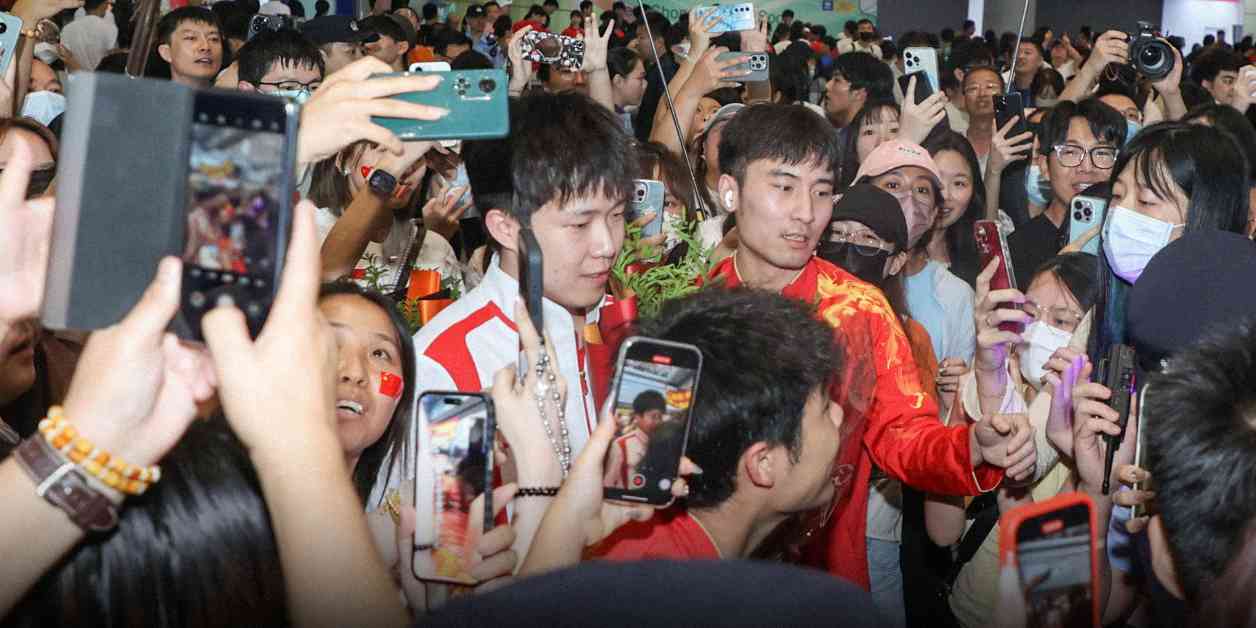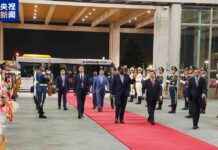The impact of fan circles on table tennis has become a controversial trend in the sport, with the passionate support of some players leading to both positive and negative outcomes. The recent final match at the Paris Olympics between Chinese table tennis players Chen Meng and Sun Yingsha highlighted this phenomenon, as Chinese spectators overwhelmingly cheered for Sun, even jeering Chen during the match. This behavior raised questions about the influence of fan circles in the sport, prompting a deeper examination of the dynamics at play.
Wang Chuqin, the men’s world No. 1 table tennis player, has experienced firsthand the intensity of fan circles in the sport. While he celebrated a victory with partner Sun Yingsha at the Paris Olympics, he also faced a challenging situation last fall when he was confronted by fans at a Chinese airport. The incident, captured on video and shared widely online, showcased the complexities of fan interactions with athletes off the court.
In response to the incident, Wang expressed his discomfort with fans following him and taking his photograph in various public settings, emphasizing the need for privacy and respect. He emphasized the distinction between his identity as an athlete on the court and as an ordinary person off the court, urging fans to give him space to breathe and respect his personal boundaries. The reaction to Wang’s statement underscored the divisive nature of fan circles and the conflicts that can arise among different fan groups.
The emergence of fan circle culture in China’s table tennis scene has raised questions about the impact of intense fan support on athletes and the sport as a whole. Gu Xin, a long-time follower of table tennis, distinguishes between fans who appreciate the sport for its competitive nature and those who are solely focused on individual players. She notes that genuine sports fans analyze matches and accept results, while others exhibit a more divisive mindset that revolves around allegiance to a specific player and disdain for their competitors.
The rise of fan circles has created a polarizing environment where fans mobilize quickly to defend their idols and criticize perceived injustices or disrespect. Online platforms have become battlegrounds for fan groups, with insults and rumors often circulating about athletes who are seen as threats to their favorites. The intense loyalty and protective instincts of fan circles can lead to conflicts within the fan community and put pressure on athletes to navigate these dynamics while maintaining their focus on their performance.
The role of fan clubs and social media in shaping the fan circle culture in table tennis cannot be understated. Fan clubs often serve as hubs for organizing support, managing online discussions, and coordinating activities to boost the profile of their chosen athlete. Members of fan clubs are held to strict criteria, including a demonstrated history of support for the player on social media. These clubs play a significant role in promoting athletes, organizing events, and fostering a sense of community among fans.
The influence of fan circles extends beyond online interactions to real-world events, where fans demonstrate their dedication through various gestures of support. From purchasing tickets at high prices to attending matches across the country, fans go to great lengths to show their admiration for their favorite athletes. Birthday celebrations, fan gatherings, and other events serve as opportunities for fans to connect with each other and express their devotion to the sport and its stars.
While fan circles can bring positive attention and support to athletes, they also present challenges and risks that need to be addressed. The intense scrutiny and pressure from fans can affect athletes’ mental well-being and performance, leading to conflicts and distractions that impact their focus on the sport. Athletes must navigate the demands of fan circles while maintaining their professionalism and personal boundaries to ensure a healthy balance between their public and private lives.
The commercialization and monetization of fan circles in sports have further complicated the dynamics of athlete-fan interactions. Companies and agencies capitalize on the influence of fan circles to promote athletes, generate revenue, and shape public perceptions. The commodification of fan support raises questions about the authenticity of fan interactions and the extent to which athletes are willing to engage with fan circles for financial gain.
Despite the challenges and controversies surrounding fan circles in table tennis, there are opportunities for positive engagement and growth within the sport. Fan support can drive interest in competitions, boost ticket sales, and elevate the visibility of athletes on the global stage. By fostering a culture of respect, sportsmanship, and mutual appreciation, fan circles can enhance the overall experience of table tennis for athletes, fans, and stakeholders alike.
In conclusion, the impact of fan circles on table tennis reflects a complex interplay of passion, loyalty, and commercial interests that shape the dynamics of the sport. While fan support can be a powerful force for promoting athletes and generating excitement, it also poses challenges in terms of privacy, respect, and sportsmanship. Athletes, fans, and governing bodies must work together to navigate the complexities of fan circle culture and ensure a positive and sustainable future for table tennis.

















